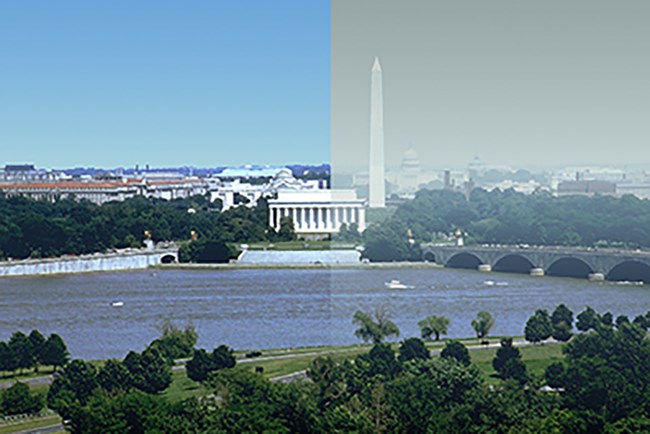A Quick Look
Air quality is generally improving. Sulfur and nitrogen deposition rates have dropped dramatically over the past 20 years. Visibility is still a concern.

Importance and Issues
Air quality affects vegetation, water, wildlife, and park scenery and views. Because air quality conditions occur over broad spatial scales, park managers have little direct control over the atmospheric conditions of the parks they manage. However, knowing about air quality conditions and changes can help park managers make planning decisions, influence off-site emitters of pollutants, and indirectly stabilize or improve park air resources. It can also help interpret changes in other vital signs.
An air quality-related value (AQRV) is a resource that may be harmed by a decline in air quality. AQRVs include visibility and specific scenic, cultural, physical, biological, ecological, or recreational resources.
Visibility is a sensitive AQRV affected by air pollution. Air pollution affects how far we can see to vistas and landscape features, and how clearly we can see them. Air pollution and light pollution also affect the darkness of the night sky.
Vegetation may be sensitive to a variety of air pollutants, including nitrogen, sulfur, and ozone. Nitrogen and sulfur affects what plants can grow and how well they grow. Ozone may cause leaf injury, slowed growth, and limit reproduction. Ozone-sensitive plant species in the NCRN include black cherry, eastern redbud, tulip poplar, Virginia pine, and Virginia creeper. Search for a list of sensitive plant species by park. Also, learn how ozone affects tree growth.
Surface waters and soils are susceptible to acidification, unnatural enrichment, or eutrophication from atmospheric deposition of hydrogen ions, nitrogen and/or sulfur. Water and soils that have evolved under low nutrient conditions, or those with low buffering capacity, are particularly vulnerable. Fish and wildlife are all potentially sensitive to air pollutants, including airborne toxics like mercury and dioxins.
Air pollutants may have a direct effect on fish and wildlife (e.g., mercury neurotoxicity) or an indirect effect on their habitat (e.g., stream acidification).

Information on air quality at National Capital Region Network parks can be found by visiting the National Park Service's Air page, which displays air quality conditions and trends in ozone, nitrogen deposition, sulfur deposition, and visibility-reducing pollutants in all parks of the National Park System.
Monitoring Questions and Approach
-
Does park air quality meet National Ambient Air Quality Standards for ozone, nitrogen deposition, and sulfur deposition?
-
Is air quality improving or declining?
-
What are the visibility conditions in parks?
Source: NPS DataStore Saved Search 1411. To search for additional information, visit the NPS DataStore.
Source: NPS DataStore Collection 973. To search for additional information, visit the NPS DataStore.
How We Monitor
Our network uses information provided by the NPS Air Resources Division to provide occasional updates on air quality in our parks.
The Clean Air Act and the National Park Service Organic Act protect air resources in national parks. Monitoring data are used to determine compliance with the National Ambient Air Quality Standards and to assess national and regional air pollution policies.
Data on ozone, visibility, and the atmospheric deposition of nitrogen, sulfur, and mercury are collected by the Clean Air Status and Trends (CASTNet).
Current Air Quality in Washington, DC
Last updated: November 9, 2023
